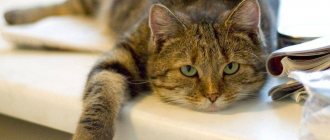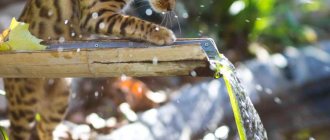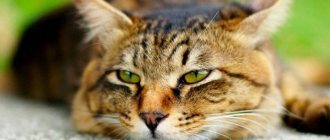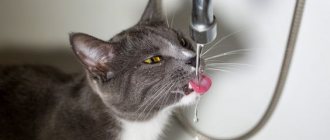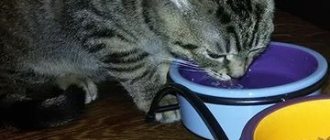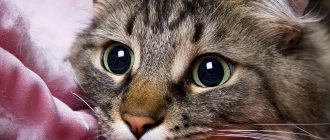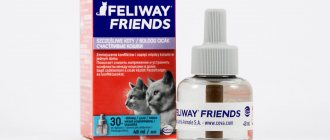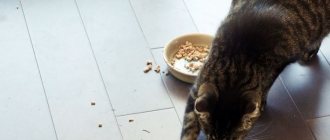Cats have a reputation for being hydrophobic. Most cats avoid getting wet as much as possible.
But some people like to play with their water bowls or look for additional sources of water in the environment.
The question is whether they do this because they are curious about water, or if they have a health problem that makes them drink a lot.
If you find your cat splashing around in a bowl of water rather than drinking it, it may have health problems.
- Why do kittens splash in the water?
- Health problems
- How to stop your cat from spilling water?
- Solving health problems
- Stress Elimination and Recommendations In the meantime, try some tricks:
- You will definitely be interested in this material:
Why do kittens splash in the water?
Kittens are generally playful and have a natural tendency to touch things with their paws. Maybe that's why they play with water. Cats groom themselves by licking their fur, so they are unlikely to use their bath water bowls. Kittens who play with water are most likely learning about the world around them in this way.
Some cats love water. There are breeds that are more tolerant of water (Maine Coons) than others. And if a young kitten is taught to take a bath, then as an adult he can be tolerant of water procedures.
There is debate about whether cats should be bathed and how often this should happen. Some cats like pond water and don't like to drink standing water in their bowls. They can play with water to recreate the effect of water ripples in natural settings.
How to bathe a cat or kitten?
Why don't cats like water?
Other theories
There are other theories that explain why cats move their water bowls around before drinking.
These:
- Who tests the temperature
- What is innate behavior, be it fishing or playing?
- Because they like to watch the movement of water.
It is also often said about some cat breeds, such as the Norwegian Forest Cat or the Maine Coon, for example, to retain the instinct to clear the surface of water from leaves or insects or to break the ice cover that would cover it in the cold regions where they originally lived.
Health problems
Before you start working on behavioral problems, take your cat to the vet to make sure there is no medical reason for his behavior.
Diabetes, kidney failure and thyroid problems can make cats thirsty. They may drink from their water bowls more often and make a mess by splashing the water or scratching it with their paws if they are not feeling well.
They may also look for other sources of water, such as a faucet or toilet. Most cats with health problems also show other signs of illness, such as lethargy, confusion, or changes in appetite.
If you observe your kitten drinking excessive amounts of water or spending a lot of time focused on his water bowl, be sure to contact your veterinarian.
Anxiety or stress sometimes causes strange behavior in cats. The cat may put its paws in the water bowl or try to climb directly into the bowl. Separation anxiety often causes cats to seek attention from their owners by exhibiting abnormal behavior.
Sometimes this manifests itself as problems with litter boxes, marking objects, or defecating in the wrong place. For some cats, separation anxiety may cause them to splash around in the water bowl, push it to the side, or turn it over to get your attention.
Obsessive-compulsive disorder can also be aggravated by stress.
The dangers of insufficient fluid intake
If a cat doesn't drink enough, it becomes chronically dehydrated. First of all, owners notice problems with the coat - it becomes dull and falls out. Then the urinary system suffers. The urine becomes too concentrated and the salt crystals it contains precipitate. First, “sand” is formed, and then larger stones. Urolithiasis is especially dangerous for males - sand clogs the long and thin urethra, causing urinary retention.
Water is also important for digestion. Chronic dehydration causes constipation. If your pet's poop is hard as pebbles, this is a warning sign.
When dehydrated, your blood becomes thicker and your blood pressure rises. This is especially dangerous for cats with kidney or heart failure.
Too little water...
Usually, owners think about how to get a cat to drink water precisely after the appearance of serious health problems - an attack of cystitis or urolithiasis, since such diseases return again and again.
How to stop your cat from spilling water?
Sometimes a kitten playing in the water is just having fun. Some young cats love to be in contact with water, while others simply cannot stand it. Kittens tend to outgrow some behavior like splashing in water, so patience may be the best solution.
Play may be at its strongest for up to five months and begins to decline after that, so if the behavior does not begin to subside it may be helpful to turn his attention to other play items.
Should a cat be prohibited from drinking water with its paw?
In many cases, the cat will not need to stop drinking water with its paw. This is what they like and it doesn't necessarily cause any harm. In addition, the cat will often lick their paws dry afterward.
However, there are times when this can become a problem. If the reason they are drinking with their paw is because they are stressed or not feeling well, then we need to take them to the vet. However, this question may be a little more practical. When they drink water with their paw, it often happens that the floor around them becomes wet. They may even leave small paw prints all over the house.
To the extent possible, we will need to understand their behavior and only intervene if their well-being is at risk. It may also be that this behavior highlights that something is missing in their life and gives us an opportunity to make improvements.
Cat fountain
Remember that drinking water from a bowl can be a little boring for cats, especially if they are picky. Not only do cats want to drink fresh water, but they may also want to have fun and get cognitive stimulation when they drink. This is especially true for some cat breeds that love water more than others.
For this reason, purchasing a cat fountain may be a good idea. This will provide them with fresh moving water, which will keep them more engaged. They will also have more fun, which can improve their overall well-being. Cat water fountains can also help keep you hydrated, as they often encourage your cat to drink more water.
Bowl of the right size and height
If your cat's problem is that her bowl is too small or low, then the solution may simply be to get a larger bowl and place it at a more appropriate height. This doesn't mean that all cat bowls should be raised, but it may be better for your individual cat. This is especially true for cats with mobility issues.
Enriched and calm environment
Finally, if your cat drinks water with its paw, it may be because it is feeling stressed, insecure, or nervous. There are many reasons why a cat becomes stressed, but lack of environmental enrichment is an important one. The solution may be quite simple. The cat may find placing the water bowl too stressful, and if there are a lot of people around or a lot of noise, we should move them somewhere quieter.
If the bowl is already somewhere calm and away from their litter box, it is possible that there are other reasons for stress. In these cases, you will need to find the root cause and fix it.
Elimination of stress and recommendations
Managing stressful situations can be difficult. If you can't pinpoint the problem, a board-certified veterinarian can help. He will give recommendations that are necessary to combat the problem.
In the meantime, try some tricks:
If you have a shower or bathtub, consider placing a bowl filled with water in it and showing it to your cat. You can increase your cat's interest with treats and praise. This way she can get used to playing with water bowls only inside the bathtub, where spills won't be a problem.
Change the water in the bowl frequently—at least once a day. You can add ice cubes to keep the water cold. But some cats may see these cubes as toys and will play with their water even more. Everything is individual.
Try alternative water containers. For example, such an option as a device for watering guinea pigs or other small animals.
Try using a fountain type water bowl with a continuous flow cycle to keep the water fresh.
The water dish is too small
If your cat regularly drinks water from her paw, we should take a look at her water dish or bowl. A cat has whiskers that serve various functions, one of which is to aid in spatial awareness. If a cat's water bowl is too small, it can put pressure on their whiskers, making them feel uncomfortable. To avoid this unpleasant sensation, they can dip their paw in water to drink.
We see this when a cat drinks from other vessels. It is not uncommon for cats to drink from our own water glasses if we leave them unaccompanied. Some cats will poke their face right in, but others will use their paw if they are more careful. We change their cup to a wider one if we think this may be the reason they are drinking from their paw.
Their water is disgusting
Although some cats will drink from a bowl, using their rough tongue to lap up the water. In general, however, most prefer fresh water or even moving water. This is because standing water can be dangerous in the wild. If they drink from a moving stream, it will likely be better for them. This could also be the reason why your cat drinks water from your glass or even from the tap , as the water you drink may be more palatable to them.
It's fun
Another reason why a cat drinks from their paw is simply because they enjoy it. A cat will look at anything in its environment and see if it can derive some entertainment from it. This includes playing with water . While this is not usually a problem, it can be a symptom of a problem if they don't have enough environmental enrichment, meaning you may have to provide more distractions such as toys or scratchers.
Why does a cat turn over a bowl of water?
An overturned glass of water, a turned laptop screen, a broken vase of flowers, a phone falling off the table - these are just a few examples of the most common sins of cats.
The cat turns the bowl over... out of curiosity
Innate curiosity leads to a desire to experiment - in this respect they resemble children. The cat turns to see what happens next. Will there be noise, or will it turn out that the overturned object will suddenly reveal some interesting properties? After all, sometimes really interesting things happen - liquid pours out of an overturned bowl, toilet paper begins to unwind... And the cat’s day immediately becomes more interesting!
Why does a cat dig up water?
Magazine “Friend for Cat Lovers” 2022
Cats are mysterious creatures that have lived next to man for millennia, but have never fully revealed all their secrets. The owner of a cat sometimes has no idea how many more amazing secrets are hidden in the mysterious cat’s soul and what unexpected surprises the most ordinary cat can present with its behavior.
One such feature is the unusual desire of cats to dig for water in a bowl, wet their paws there, spill water, or dig near a bowl of water. Surprisingly, this is not such a rare occurrence and there is nothing strange about this behavior.
Cats love to play, and water is one of the most fun toys. There is nothing mysterious about this: the reflections and excitement of the water awaken the hunting instincts in the cat. Cats really like to create waves with their paws, and then watch or even “catch” the play of light on the surface. Sometimes they splash water while playing and there is nothing left in the bowl. If you want to prevent your cat from playing with water, just buy additional toys for her: teasers (you can even use automatic ones if you are away from home for a long time), mice, balls, all kinds of soft toys for cats, etc. Play with your pet often so that he gets tired and does not seek entertainment in the water.
Another reason why cats can splash water with their paw is instinct. The distant (or not so distant) ancestors of our pets drank running water from rivers or streams. They subconsciously understood that running water was the cleanest, healthiest and best. And sometimes this instinct awakens in our domestic cats. In this case, it is best for you to purchase special drinking fountains, they are designed specifically for cats and are equipped with filters that constantly purify the water. The water for your cat will always be clean and served in a form that suits her.
Why does a cat dig near a bowl of food?
It happens that a cat digs on the floor and near an empty bowl. This may indicate that the pet is not eating enough and, obeying instinct, tries to dig up supplies. The reason why a cat may refuse to eat and try to bury food may be a restless place.
Interesting materials:
Approximately how much does 1 plum weigh? How much durability does a diamond pickaxe have? How many views on YouTube is opa gangam style? What percentage of alcohol is in beer? What percentage is glucose? What percentage of starch is in corn? What percentage of sugar is in milk? How many districts are there in Uzbekistan? How many Rakats to recite Asr? How many times do children get a flu shot?
Reflexes, instincts, habits of cats
The cat is originally a predator; it has retained a wide variety of instincts and unconditioned reflexes. Instinct is the ability to act one way and not another, guided by subconscious beliefs.
All instincts can be divided into three main groups:
- The first group includes instincts that ensure the functioning of the body: food instinct, sleep instinct, etc. These instincts are simply necessary for any animal; life is impossible without them.
- The second group includes instincts that help individuals communicate and interact: parental instinct, sexual instinct, etc.
- The third group includes: the instinct of play, exploration and imitation.
When doing certain things, a cat is guided by its instincts, therefore, if a cat grabs a bowl with its food, this can be explained by the presence of certain instincts and reflexes in all cats.
Why does a cat spill water from a bowl?
There is a myth that purrs are afraid of water.
Many argue that this is already ingrained in them at the genetic level, because in most cases, careless owners get rid of unwanted offspring in a not entirely humane way. Blind kittens are drowned, although it is more optimal to sterilize the animal and no longer worry about where to put the cubs. Because of the fear of water, it is difficult to bathe the animal. It begins to scratch and break out. However, if this procedure is still necessary because the pet is heavily soiled, it is important not to wet the ears, as this can cause them to become inflamed and painful.
Unlike dogs, purrs do not need to be bathed. They are very clean and very careful about hygiene. They have a keen sense of smell, like all predators, so they lick themselves at the slightest unpleasant odor. Mainly after eating and going to the toilet.
Why does a cat spill water from a bowl?
There is a myth that purrs are afraid of water. Many argue that this is already ingrained in them at the genetic level, because in most cases, careless owners get rid of unwanted offspring in a not entirely humane way. Blind kittens are drowned, although it is more optimal to sterilize the animal and no longer worry about where to put the cubs. Because of the fear of water, it is difficult to bathe the animal. It begins to scratch and break out. However, if this procedure is still necessary because the pet is heavily soiled, it is important not to wet the ears, as this can cause them to become inflamed and painful.
How do cat eyes work?
Cats' eyes are optimized for viewing at dusk or twilight. Their night vision is 6-8 times better than ours... We could look for the reason in their ancestors, who had to adapt to night hunting in order to get the food they needed...
next, The eyes of our furry friends are larger in size than those of humans... This also makes night vision easier. But, and there is always a but, it prevents them from focusing on short distances.
Cats cannot concentrate on anything smaller than 30 centimeters. For this reason, they should look for other ways to know the water level in their pools...
Cat turns over a bowl of water and food
What smells do cats not like?
Should you walk your cat?
It's so strange that a cat's paw often sticks suspiciously to various objects. Where does this mania for knocking them over come from?
What can fall or overturn will certainly fall or overturn, no later than in a few minutes. Does this principle also apply in your home? It so happens that the vast majority of cats profess it. But what is really behind it? Why does a cat try so hard to knock over its bowl, various things, and even throw them on top?

